Comprehensive Literature Review on Team Leadership Effectiveness
VerifiedAdded on 2020/05/28
|21
|5014
|161
Literature Review
AI Summary
This literature review examines the concept of team leadership, focusing on its definition, importance, and impact on organizational success. It delves into the Team Leadership Model of Hill, outlining its components and application in real-world business scenarios, such as the Chilean mine case. The review explores leadership qualities, styles, and their influence on team effectiveness, encompassing both internal and external leadership actions. It also addresses team development and performance, providing a framework for assessing team effectiveness through key questions. Furthermore, the paper highlights gaps in existing literature, offering a comprehensive overview of team leadership principles and practices, with the aim of guiding leaders towards achieving predetermined goals and fostering motivated organizational environments. This resource is available on Desklib, a platform providing study tools for students.
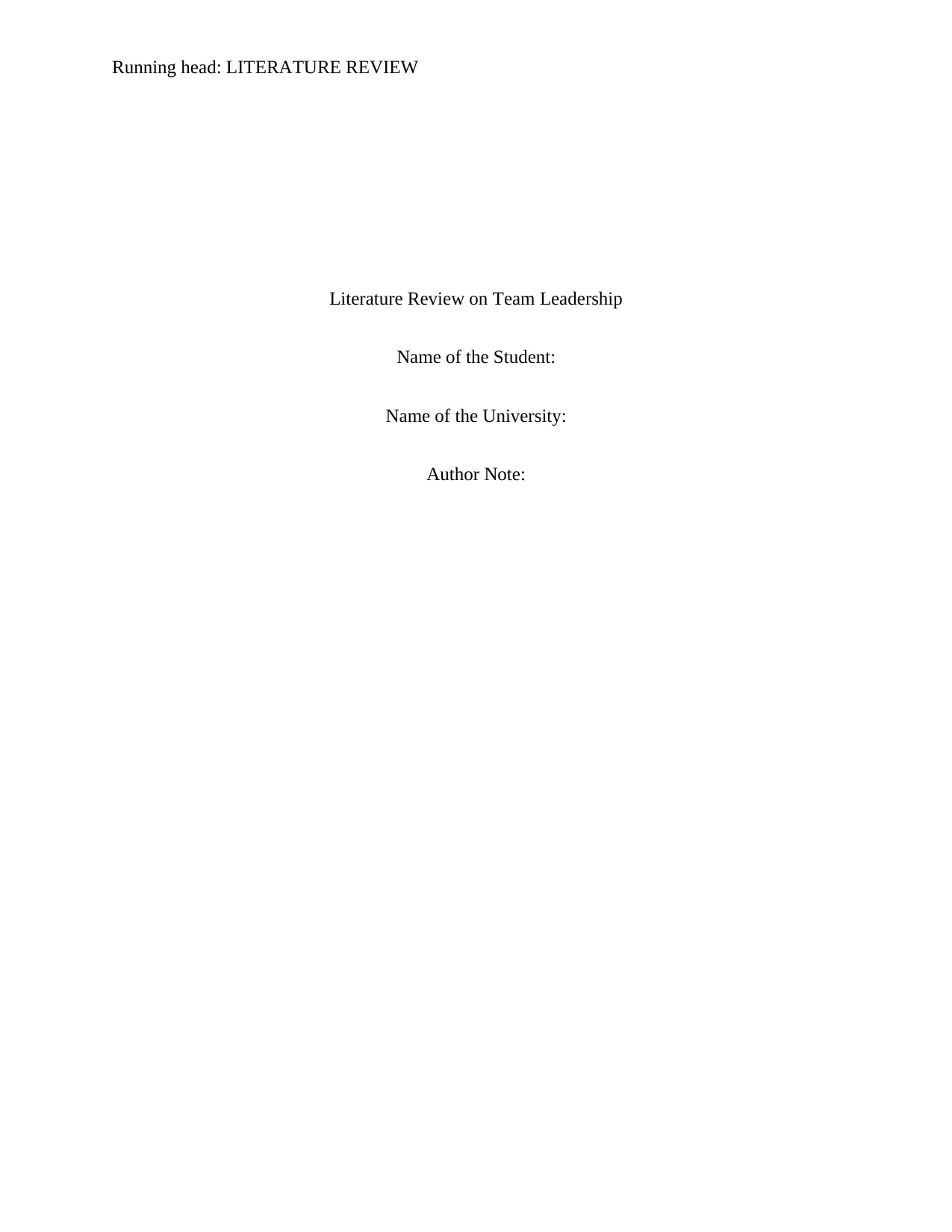
Running head: LITERATURE REVIEW
Literature Review on Team Leadership
Name of the Student:
Name of the University:
Author Note:
Literature Review on Team Leadership
Name of the Student:
Name of the University:
Author Note:
Paraphrase This Document
Need a fresh take? Get an instant paraphrase of this document with our AI Paraphraser
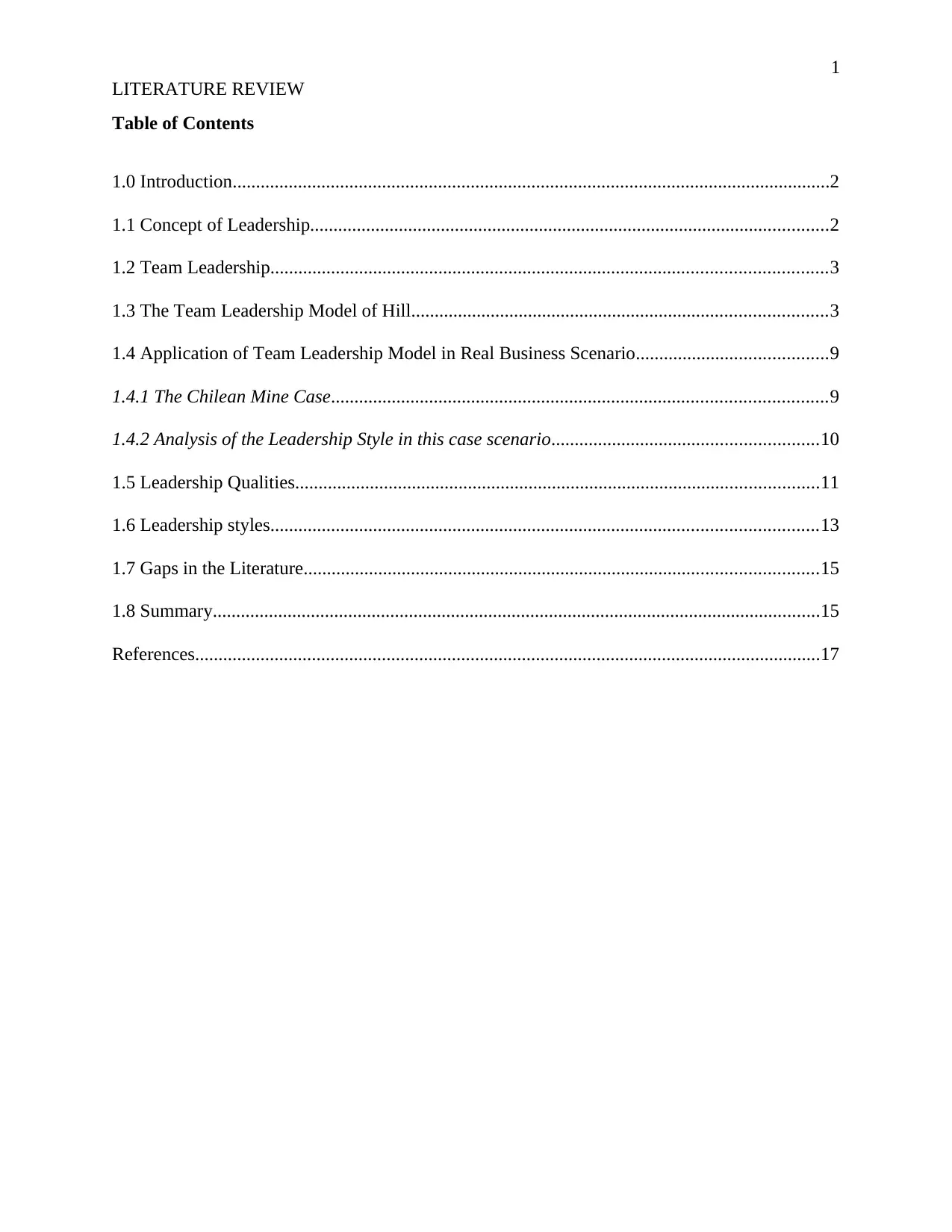
1
LITERATURE REVIEW
Table of Contents
1.0 Introduction................................................................................................................................2
1.1 Concept of Leadership...............................................................................................................2
1.2 Team Leadership.......................................................................................................................3
1.3 The Team Leadership Model of Hill.........................................................................................3
1.4 Application of Team Leadership Model in Real Business Scenario.........................................9
1.4.1 The Chilean Mine Case..........................................................................................................9
1.4.2 Analysis of the Leadership Style in this case scenario.........................................................10
1.5 Leadership Qualities................................................................................................................11
1.6 Leadership styles.....................................................................................................................13
1.7 Gaps in the Literature..............................................................................................................15
1.8 Summary..................................................................................................................................15
References......................................................................................................................................17
LITERATURE REVIEW
Table of Contents
1.0 Introduction................................................................................................................................2
1.1 Concept of Leadership...............................................................................................................2
1.2 Team Leadership.......................................................................................................................3
1.3 The Team Leadership Model of Hill.........................................................................................3
1.4 Application of Team Leadership Model in Real Business Scenario.........................................9
1.4.1 The Chilean Mine Case..........................................................................................................9
1.4.2 Analysis of the Leadership Style in this case scenario.........................................................10
1.5 Leadership Qualities................................................................................................................11
1.6 Leadership styles.....................................................................................................................13
1.7 Gaps in the Literature..............................................................................................................15
1.8 Summary..................................................................................................................................15
References......................................................................................................................................17
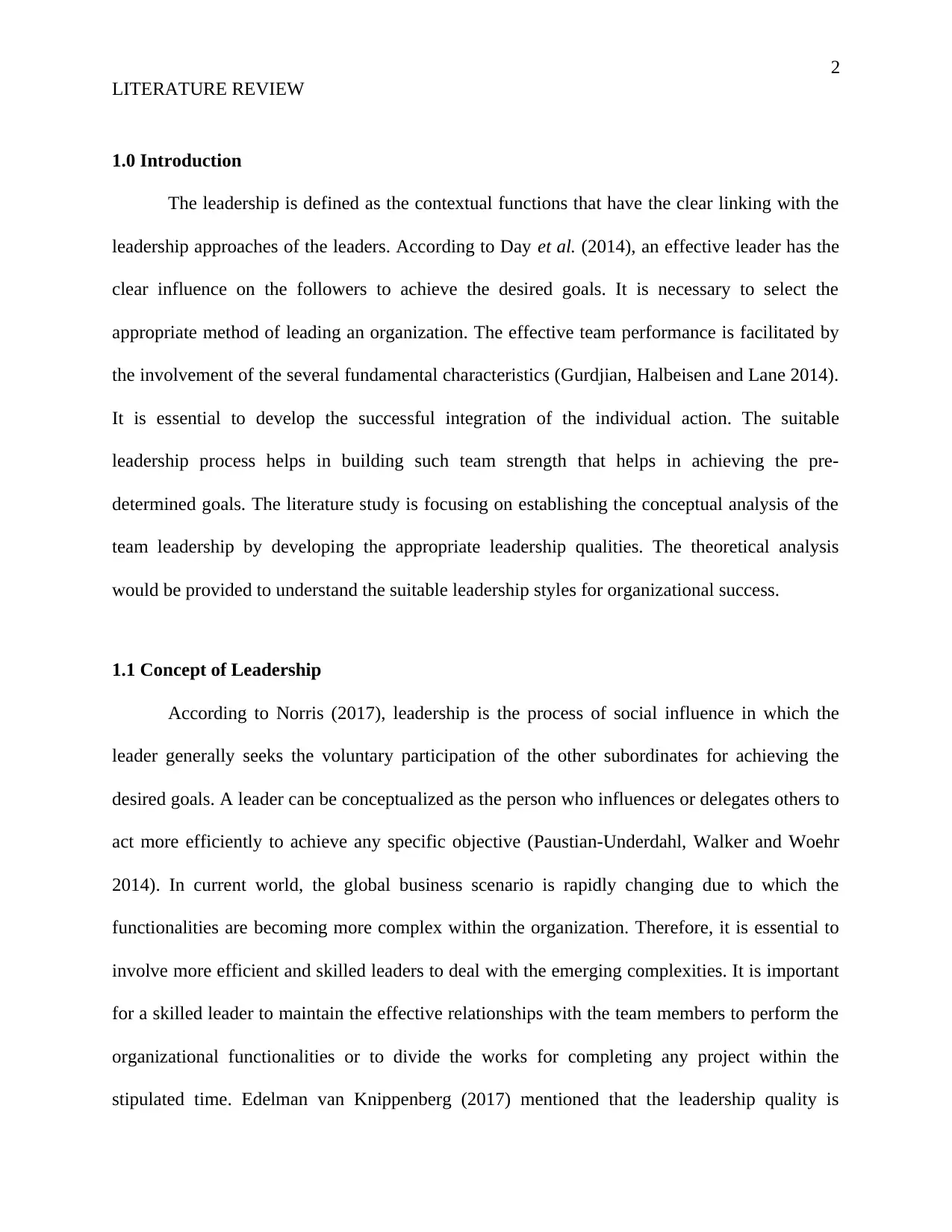
2
LITERATURE REVIEW
1.0 Introduction
The leadership is defined as the contextual functions that have the clear linking with the
leadership approaches of the leaders. According to Day et al. (2014), an effective leader has the
clear influence on the followers to achieve the desired goals. It is necessary to select the
appropriate method of leading an organization. The effective team performance is facilitated by
the involvement of the several fundamental characteristics (Gurdjian, Halbeisen and Lane 2014).
It is essential to develop the successful integration of the individual action. The suitable
leadership process helps in building such team strength that helps in achieving the pre-
determined goals. The literature study is focusing on establishing the conceptual analysis of the
team leadership by developing the appropriate leadership qualities. The theoretical analysis
would be provided to understand the suitable leadership styles for organizational success.
1.1 Concept of Leadership
According to Norris (2017), leadership is the process of social influence in which the
leader generally seeks the voluntary participation of the other subordinates for achieving the
desired goals. A leader can be conceptualized as the person who influences or delegates others to
act more efficiently to achieve any specific objective (Paustian-Underdahl, Walker and Woehr
2014). In current world, the global business scenario is rapidly changing due to which the
functionalities are becoming more complex within the organization. Therefore, it is essential to
involve more efficient and skilled leaders to deal with the emerging complexities. It is important
for a skilled leader to maintain the effective relationships with the team members to perform the
organizational functionalities or to divide the works for completing any project within the
stipulated time. Edelman van Knippenberg (2017) mentioned that the leadership quality is
LITERATURE REVIEW
1.0 Introduction
The leadership is defined as the contextual functions that have the clear linking with the
leadership approaches of the leaders. According to Day et al. (2014), an effective leader has the
clear influence on the followers to achieve the desired goals. It is necessary to select the
appropriate method of leading an organization. The effective team performance is facilitated by
the involvement of the several fundamental characteristics (Gurdjian, Halbeisen and Lane 2014).
It is essential to develop the successful integration of the individual action. The suitable
leadership process helps in building such team strength that helps in achieving the pre-
determined goals. The literature study is focusing on establishing the conceptual analysis of the
team leadership by developing the appropriate leadership qualities. The theoretical analysis
would be provided to understand the suitable leadership styles for organizational success.
1.1 Concept of Leadership
According to Norris (2017), leadership is the process of social influence in which the
leader generally seeks the voluntary participation of the other subordinates for achieving the
desired goals. A leader can be conceptualized as the person who influences or delegates others to
act more efficiently to achieve any specific objective (Paustian-Underdahl, Walker and Woehr
2014). In current world, the global business scenario is rapidly changing due to which the
functionalities are becoming more complex within the organization. Therefore, it is essential to
involve more efficient and skilled leaders to deal with the emerging complexities. It is important
for a skilled leader to maintain the effective relationships with the team members to perform the
organizational functionalities or to divide the works for completing any project within the
stipulated time. Edelman van Knippenberg (2017) mentioned that the leadership quality is
⊘ This is a preview!⊘
Do you want full access?
Subscribe today to unlock all pages.

Trusted by 1+ million students worldwide
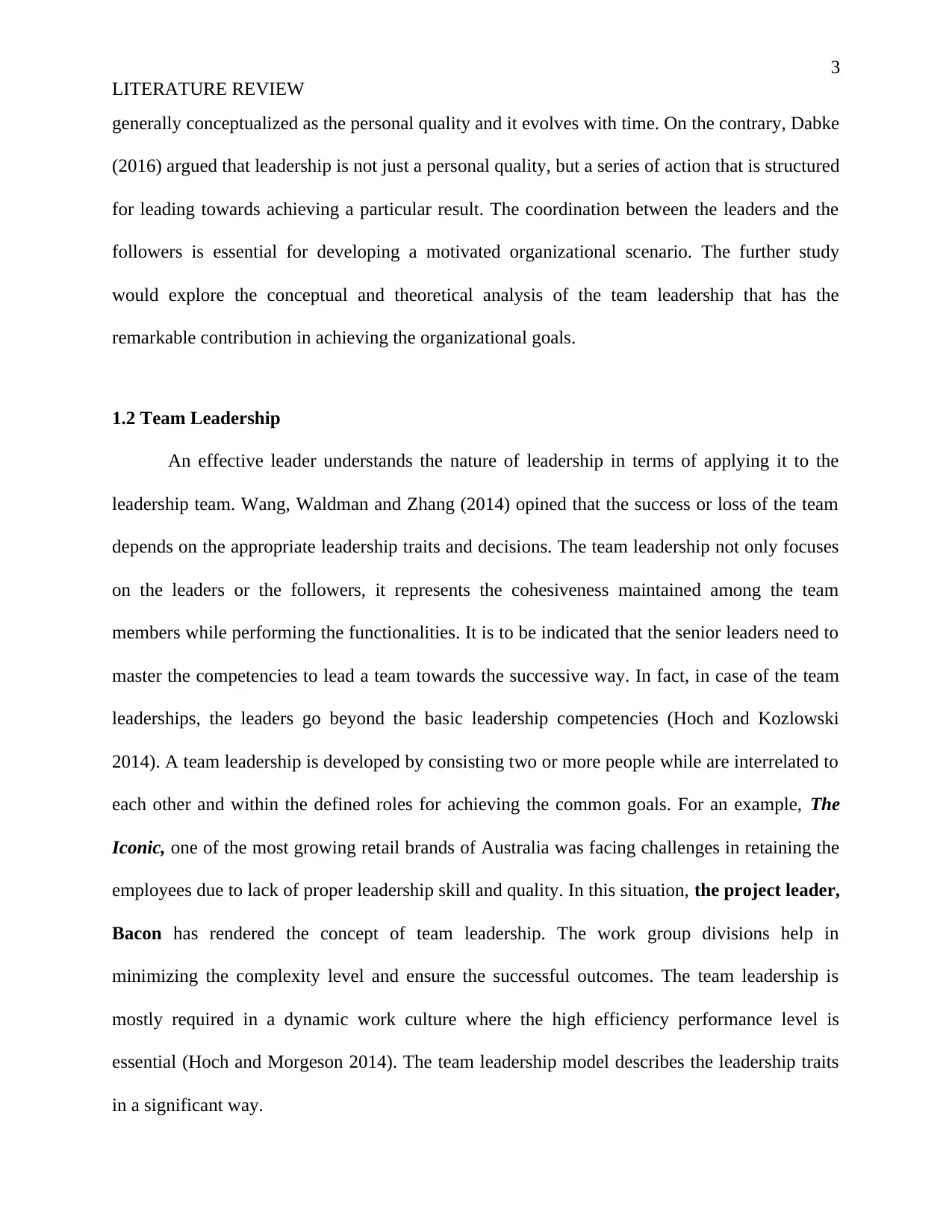
3
LITERATURE REVIEW
generally conceptualized as the personal quality and it evolves with time. On the contrary, Dabke
(2016) argued that leadership is not just a personal quality, but a series of action that is structured
for leading towards achieving a particular result. The coordination between the leaders and the
followers is essential for developing a motivated organizational scenario. The further study
would explore the conceptual and theoretical analysis of the team leadership that has the
remarkable contribution in achieving the organizational goals.
1.2 Team Leadership
An effective leader understands the nature of leadership in terms of applying it to the
leadership team. Wang, Waldman and Zhang (2014) opined that the success or loss of the team
depends on the appropriate leadership traits and decisions. The team leadership not only focuses
on the leaders or the followers, it represents the cohesiveness maintained among the team
members while performing the functionalities. It is to be indicated that the senior leaders need to
master the competencies to lead a team towards the successive way. In fact, in case of the team
leaderships, the leaders go beyond the basic leadership competencies (Hoch and Kozlowski
2014). A team leadership is developed by consisting two or more people while are interrelated to
each other and within the defined roles for achieving the common goals. For an example, The
Iconic, one of the most growing retail brands of Australia was facing challenges in retaining the
employees due to lack of proper leadership skill and quality. In this situation, the project leader,
Bacon has rendered the concept of team leadership. The work group divisions help in
minimizing the complexity level and ensure the successful outcomes. The team leadership is
mostly required in a dynamic work culture where the high efficiency performance level is
essential (Hoch and Morgeson 2014). The team leadership model describes the leadership traits
in a significant way.
LITERATURE REVIEW
generally conceptualized as the personal quality and it evolves with time. On the contrary, Dabke
(2016) argued that leadership is not just a personal quality, but a series of action that is structured
for leading towards achieving a particular result. The coordination between the leaders and the
followers is essential for developing a motivated organizational scenario. The further study
would explore the conceptual and theoretical analysis of the team leadership that has the
remarkable contribution in achieving the organizational goals.
1.2 Team Leadership
An effective leader understands the nature of leadership in terms of applying it to the
leadership team. Wang, Waldman and Zhang (2014) opined that the success or loss of the team
depends on the appropriate leadership traits and decisions. The team leadership not only focuses
on the leaders or the followers, it represents the cohesiveness maintained among the team
members while performing the functionalities. It is to be indicated that the senior leaders need to
master the competencies to lead a team towards the successive way. In fact, in case of the team
leaderships, the leaders go beyond the basic leadership competencies (Hoch and Kozlowski
2014). A team leadership is developed by consisting two or more people while are interrelated to
each other and within the defined roles for achieving the common goals. For an example, The
Iconic, one of the most growing retail brands of Australia was facing challenges in retaining the
employees due to lack of proper leadership skill and quality. In this situation, the project leader,
Bacon has rendered the concept of team leadership. The work group divisions help in
minimizing the complexity level and ensure the successful outcomes. The team leadership is
mostly required in a dynamic work culture where the high efficiency performance level is
essential (Hoch and Morgeson 2014). The team leadership model describes the leadership traits
in a significant way.
Paraphrase This Document
Need a fresh take? Get an instant paraphrase of this document with our AI Paraphraser
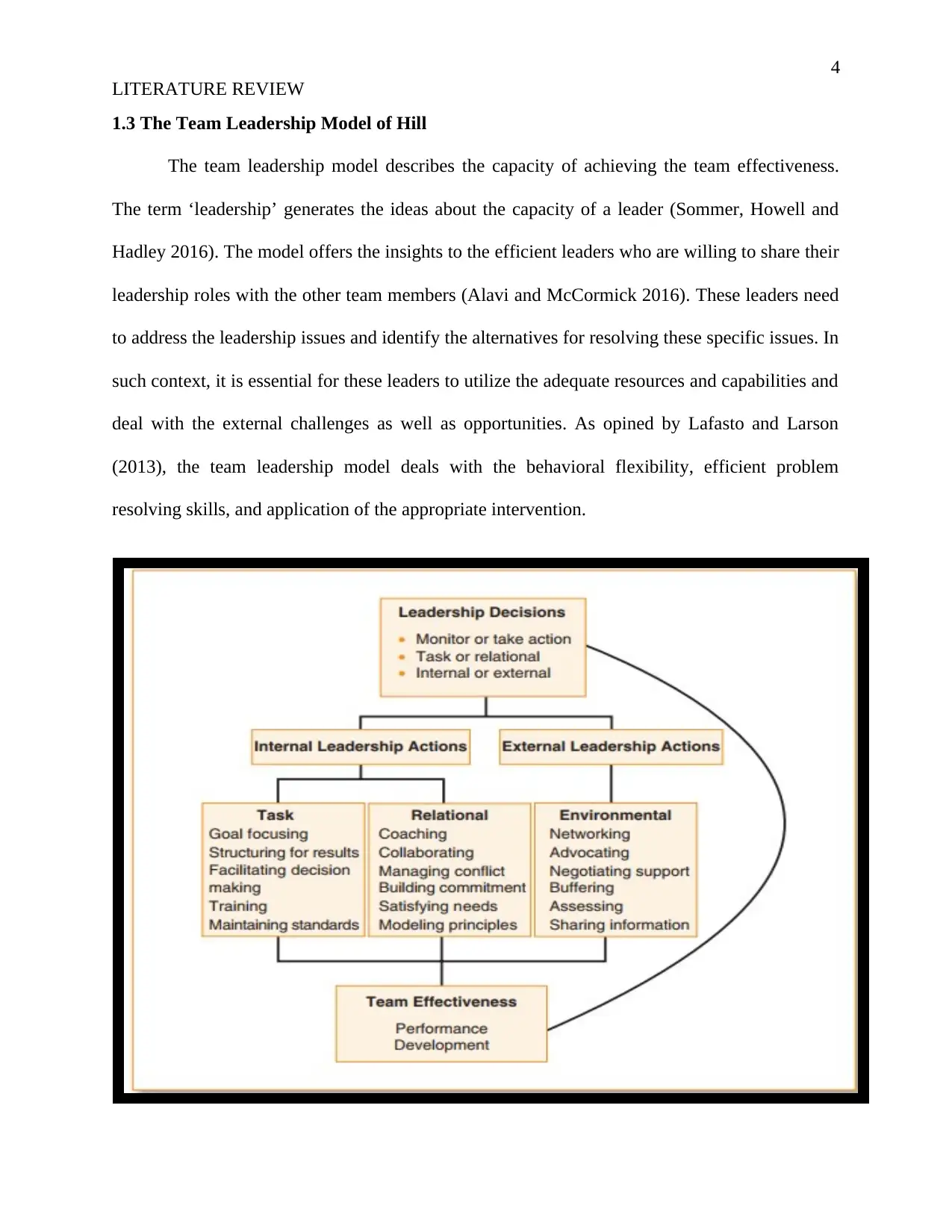
4
LITERATURE REVIEW
1.3 The Team Leadership Model of Hill
The team leadership model describes the capacity of achieving the team effectiveness.
The term ‘leadership’ generates the ideas about the capacity of a leader (Sommer, Howell and
Hadley 2016). The model offers the insights to the efficient leaders who are willing to share their
leadership roles with the other team members (Alavi and McCormick 2016). These leaders need
to address the leadership issues and identify the alternatives for resolving these specific issues. In
such context, it is essential for these leaders to utilize the adequate resources and capabilities and
deal with the external challenges as well as opportunities. As opined by Lafasto and Larson
(2013), the team leadership model deals with the behavioral flexibility, efficient problem
resolving skills, and application of the appropriate intervention.
LITERATURE REVIEW
1.3 The Team Leadership Model of Hill
The team leadership model describes the capacity of achieving the team effectiveness.
The term ‘leadership’ generates the ideas about the capacity of a leader (Sommer, Howell and
Hadley 2016). The model offers the insights to the efficient leaders who are willing to share their
leadership roles with the other team members (Alavi and McCormick 2016). These leaders need
to address the leadership issues and identify the alternatives for resolving these specific issues. In
such context, it is essential for these leaders to utilize the adequate resources and capabilities and
deal with the external challenges as well as opportunities. As opined by Lafasto and Larson
(2013), the team leadership model deals with the behavioral flexibility, efficient problem
resolving skills, and application of the appropriate intervention.
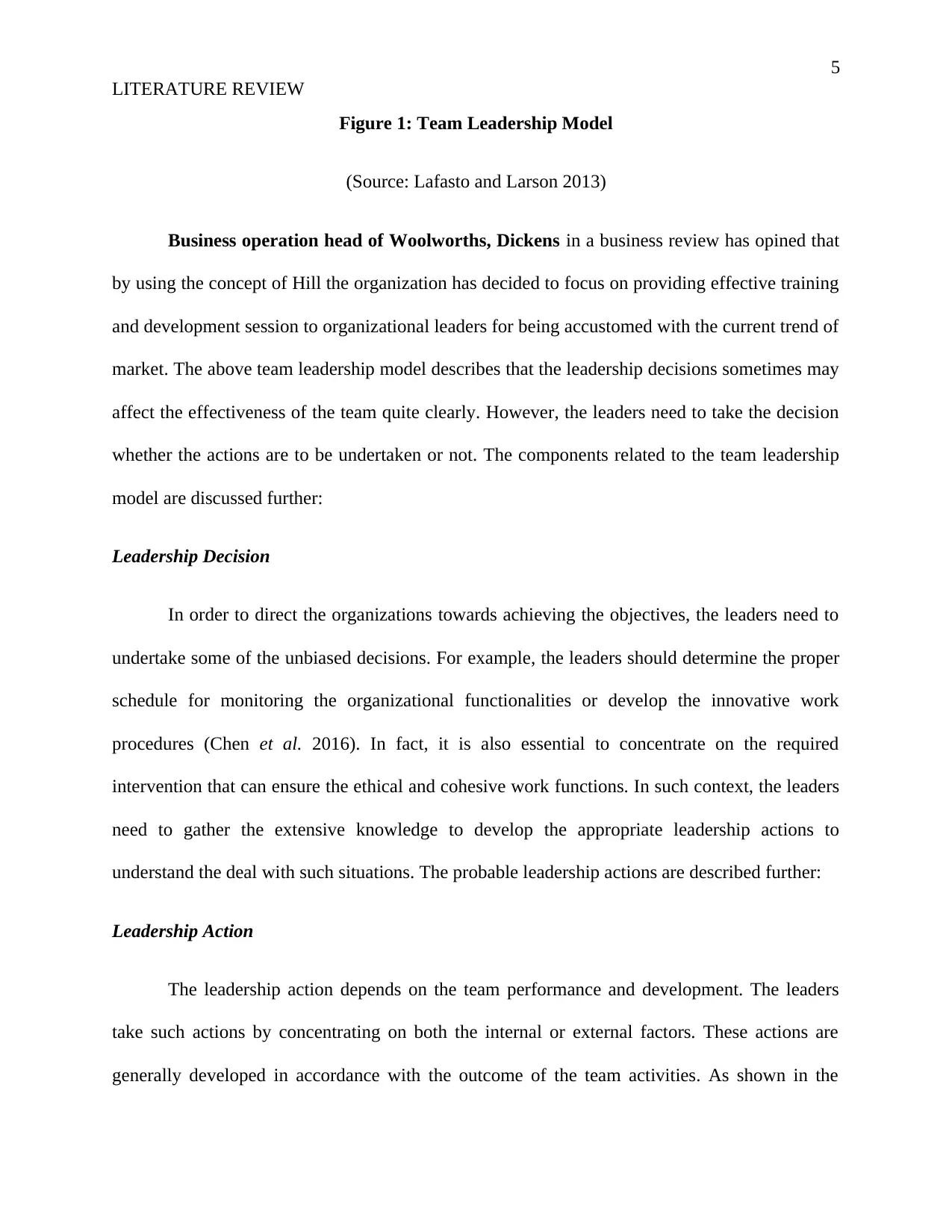
5
LITERATURE REVIEW
Figure 1: Team Leadership Model
(Source: Lafasto and Larson 2013)
Business operation head of Woolworths, Dickens in a business review has opined that
by using the concept of Hill the organization has decided to focus on providing effective training
and development session to organizational leaders for being accustomed with the current trend of
market. The above team leadership model describes that the leadership decisions sometimes may
affect the effectiveness of the team quite clearly. However, the leaders need to take the decision
whether the actions are to be undertaken or not. The components related to the team leadership
model are discussed further:
Leadership Decision
In order to direct the organizations towards achieving the objectives, the leaders need to
undertake some of the unbiased decisions. For example, the leaders should determine the proper
schedule for monitoring the organizational functionalities or develop the innovative work
procedures (Chen et al. 2016). In fact, it is also essential to concentrate on the required
intervention that can ensure the ethical and cohesive work functions. In such context, the leaders
need to gather the extensive knowledge to develop the appropriate leadership actions to
understand the deal with such situations. The probable leadership actions are described further:
Leadership Action
The leadership action depends on the team performance and development. The leaders
take such actions by concentrating on both the internal or external factors. These actions are
generally developed in accordance with the outcome of the team activities. As shown in the
LITERATURE REVIEW
Figure 1: Team Leadership Model
(Source: Lafasto and Larson 2013)
Business operation head of Woolworths, Dickens in a business review has opined that
by using the concept of Hill the organization has decided to focus on providing effective training
and development session to organizational leaders for being accustomed with the current trend of
market. The above team leadership model describes that the leadership decisions sometimes may
affect the effectiveness of the team quite clearly. However, the leaders need to take the decision
whether the actions are to be undertaken or not. The components related to the team leadership
model are discussed further:
Leadership Decision
In order to direct the organizations towards achieving the objectives, the leaders need to
undertake some of the unbiased decisions. For example, the leaders should determine the proper
schedule for monitoring the organizational functionalities or develop the innovative work
procedures (Chen et al. 2016). In fact, it is also essential to concentrate on the required
intervention that can ensure the ethical and cohesive work functions. In such context, the leaders
need to gather the extensive knowledge to develop the appropriate leadership actions to
understand the deal with such situations. The probable leadership actions are described further:
Leadership Action
The leadership action depends on the team performance and development. The leaders
take such actions by concentrating on both the internal or external factors. These actions are
generally developed in accordance with the outcome of the team activities. As shown in the
⊘ This is a preview!⊘
Do you want full access?
Subscribe today to unlock all pages.

Trusted by 1+ million students worldwide
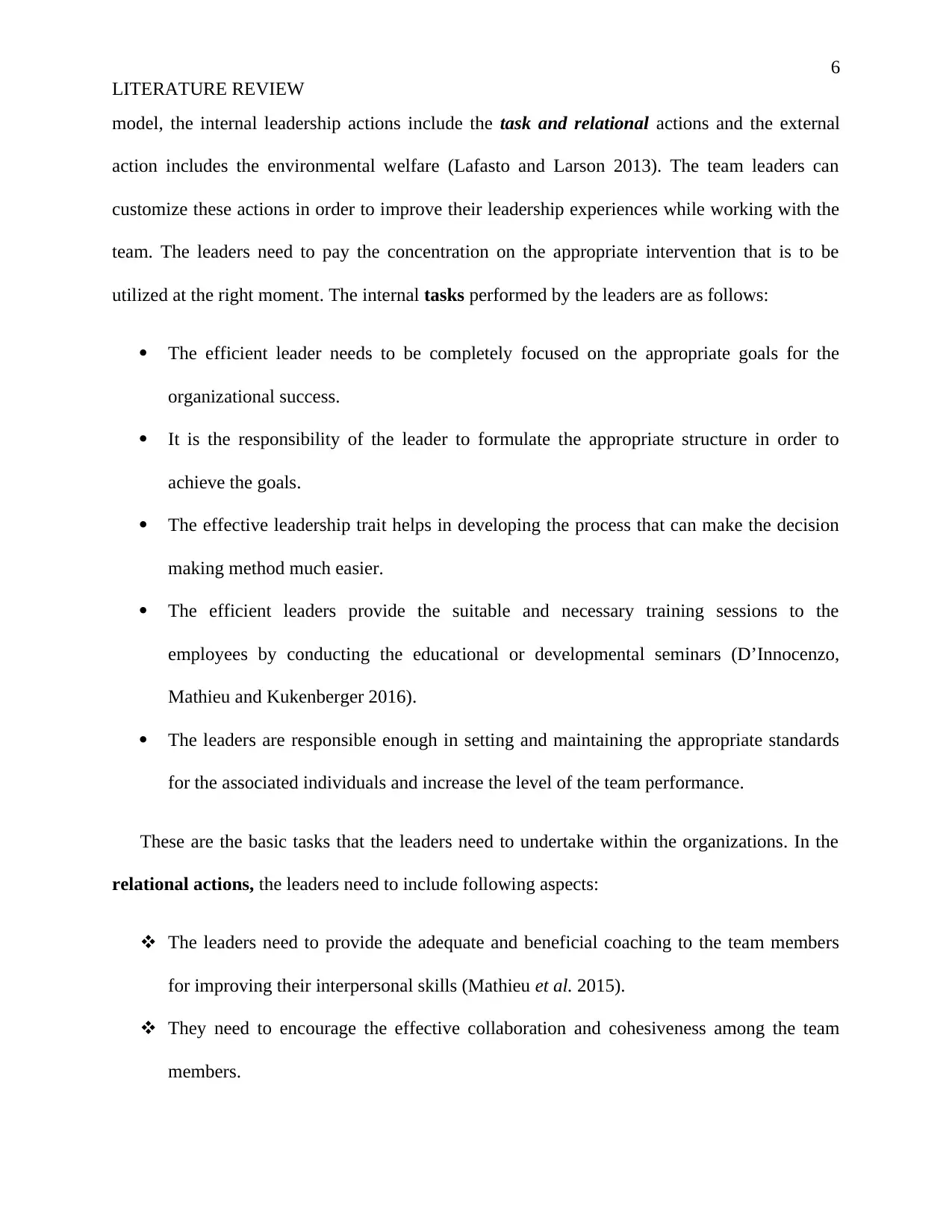
6
LITERATURE REVIEW
model, the internal leadership actions include the task and relational actions and the external
action includes the environmental welfare (Lafasto and Larson 2013). The team leaders can
customize these actions in order to improve their leadership experiences while working with the
team. The leaders need to pay the concentration on the appropriate intervention that is to be
utilized at the right moment. The internal tasks performed by the leaders are as follows:
The efficient leader needs to be completely focused on the appropriate goals for the
organizational success.
It is the responsibility of the leader to formulate the appropriate structure in order to
achieve the goals.
The effective leadership trait helps in developing the process that can make the decision
making method much easier.
The efficient leaders provide the suitable and necessary training sessions to the
employees by conducting the educational or developmental seminars (D’Innocenzo,
Mathieu and Kukenberger 2016).
The leaders are responsible enough in setting and maintaining the appropriate standards
for the associated individuals and increase the level of the team performance.
These are the basic tasks that the leaders need to undertake within the organizations. In the
relational actions, the leaders need to include following aspects:
The leaders need to provide the adequate and beneficial coaching to the team members
for improving their interpersonal skills (Mathieu et al. 2015).
They need to encourage the effective collaboration and cohesiveness among the team
members.
LITERATURE REVIEW
model, the internal leadership actions include the task and relational actions and the external
action includes the environmental welfare (Lafasto and Larson 2013). The team leaders can
customize these actions in order to improve their leadership experiences while working with the
team. The leaders need to pay the concentration on the appropriate intervention that is to be
utilized at the right moment. The internal tasks performed by the leaders are as follows:
The efficient leader needs to be completely focused on the appropriate goals for the
organizational success.
It is the responsibility of the leader to formulate the appropriate structure in order to
achieve the goals.
The effective leadership trait helps in developing the process that can make the decision
making method much easier.
The efficient leaders provide the suitable and necessary training sessions to the
employees by conducting the educational or developmental seminars (D’Innocenzo,
Mathieu and Kukenberger 2016).
The leaders are responsible enough in setting and maintaining the appropriate standards
for the associated individuals and increase the level of the team performance.
These are the basic tasks that the leaders need to undertake within the organizations. In the
relational actions, the leaders need to include following aspects:
The leaders need to provide the adequate and beneficial coaching to the team members
for improving their interpersonal skills (Mathieu et al. 2015).
They need to encourage the effective collaboration and cohesiveness among the team
members.
Paraphrase This Document
Need a fresh take? Get an instant paraphrase of this document with our AI Paraphraser
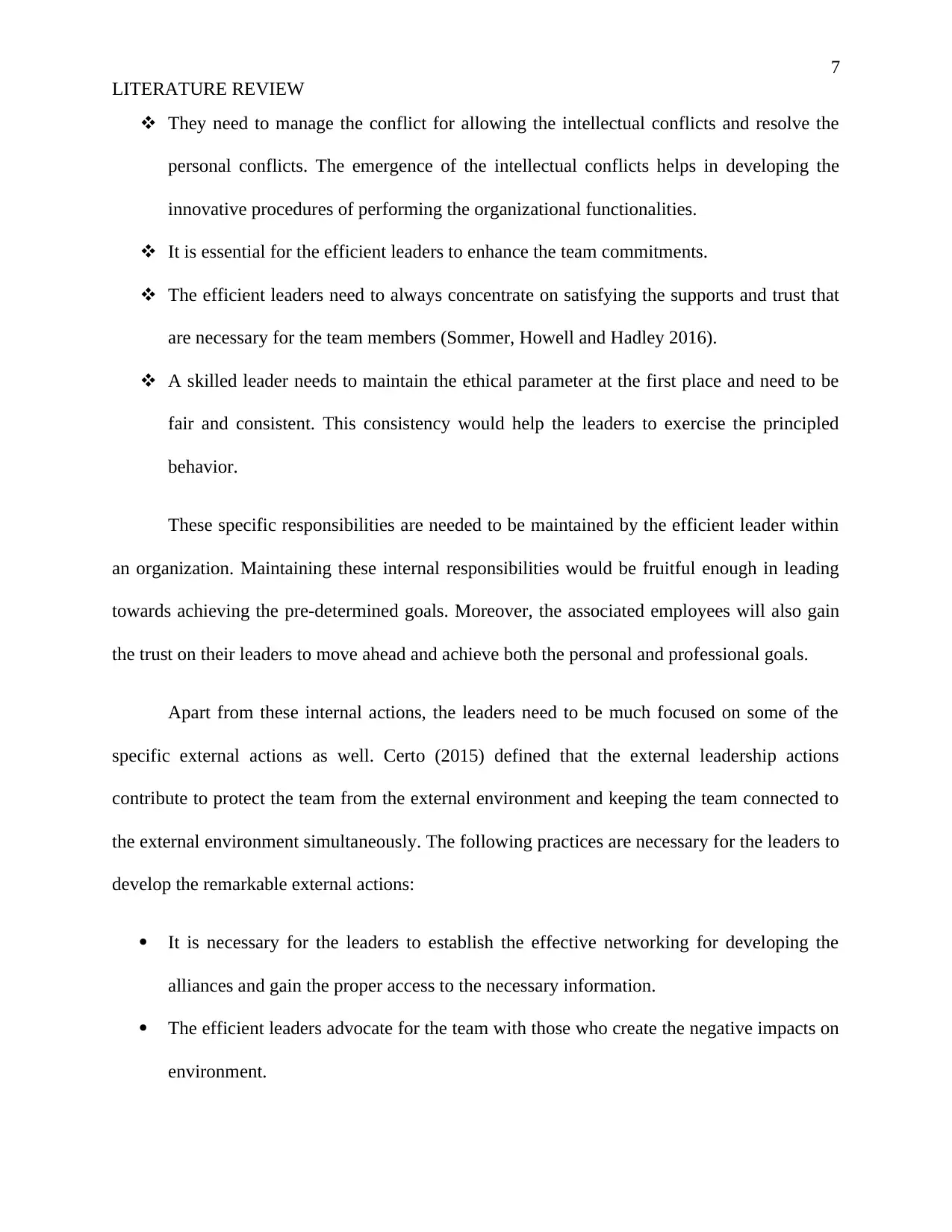
7
LITERATURE REVIEW
They need to manage the conflict for allowing the intellectual conflicts and resolve the
personal conflicts. The emergence of the intellectual conflicts helps in developing the
innovative procedures of performing the organizational functionalities.
It is essential for the efficient leaders to enhance the team commitments.
The efficient leaders need to always concentrate on satisfying the supports and trust that
are necessary for the team members (Sommer, Howell and Hadley 2016).
A skilled leader needs to maintain the ethical parameter at the first place and need to be
fair and consistent. This consistency would help the leaders to exercise the principled
behavior.
These specific responsibilities are needed to be maintained by the efficient leader within
an organization. Maintaining these internal responsibilities would be fruitful enough in leading
towards achieving the pre-determined goals. Moreover, the associated employees will also gain
the trust on their leaders to move ahead and achieve both the personal and professional goals.
Apart from these internal actions, the leaders need to be much focused on some of the
specific external actions as well. Certo (2015) defined that the external leadership actions
contribute to protect the team from the external environment and keeping the team connected to
the external environment simultaneously. The following practices are necessary for the leaders to
develop the remarkable external actions:
It is necessary for the leaders to establish the effective networking for developing the
alliances and gain the proper access to the necessary information.
The efficient leaders advocate for the team with those who create the negative impacts on
environment.
LITERATURE REVIEW
They need to manage the conflict for allowing the intellectual conflicts and resolve the
personal conflicts. The emergence of the intellectual conflicts helps in developing the
innovative procedures of performing the organizational functionalities.
It is essential for the efficient leaders to enhance the team commitments.
The efficient leaders need to always concentrate on satisfying the supports and trust that
are necessary for the team members (Sommer, Howell and Hadley 2016).
A skilled leader needs to maintain the ethical parameter at the first place and need to be
fair and consistent. This consistency would help the leaders to exercise the principled
behavior.
These specific responsibilities are needed to be maintained by the efficient leader within
an organization. Maintaining these internal responsibilities would be fruitful enough in leading
towards achieving the pre-determined goals. Moreover, the associated employees will also gain
the trust on their leaders to move ahead and achieve both the personal and professional goals.
Apart from these internal actions, the leaders need to be much focused on some of the
specific external actions as well. Certo (2015) defined that the external leadership actions
contribute to protect the team from the external environment and keeping the team connected to
the external environment simultaneously. The following practices are necessary for the leaders to
develop the remarkable external actions:
It is necessary for the leaders to establish the effective networking for developing the
alliances and gain the proper access to the necessary information.
The efficient leaders advocate for the team with those who create the negative impacts on
environment.
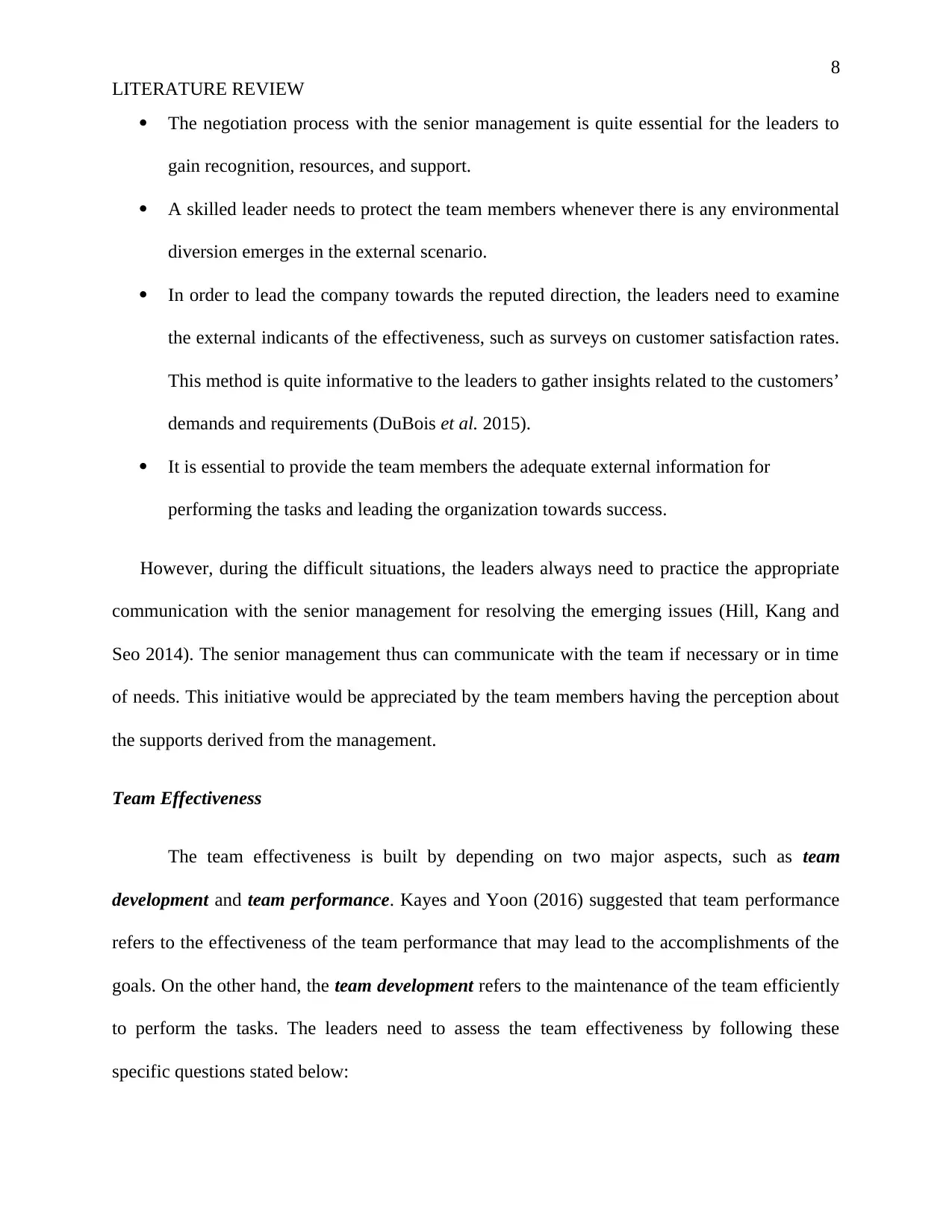
8
LITERATURE REVIEW
The negotiation process with the senior management is quite essential for the leaders to
gain recognition, resources, and support.
A skilled leader needs to protect the team members whenever there is any environmental
diversion emerges in the external scenario.
In order to lead the company towards the reputed direction, the leaders need to examine
the external indicants of the effectiveness, such as surveys on customer satisfaction rates.
This method is quite informative to the leaders to gather insights related to the customers’
demands and requirements (DuBois et al. 2015).
It is essential to provide the team members the adequate external information for
performing the tasks and leading the organization towards success.
However, during the difficult situations, the leaders always need to practice the appropriate
communication with the senior management for resolving the emerging issues (Hill, Kang and
Seo 2014). The senior management thus can communicate with the team if necessary or in time
of needs. This initiative would be appreciated by the team members having the perception about
the supports derived from the management.
Team Effectiveness
The team effectiveness is built by depending on two major aspects, such as team
development and team performance. Kayes and Yoon (2016) suggested that team performance
refers to the effectiveness of the team performance that may lead to the accomplishments of the
goals. On the other hand, the team development refers to the maintenance of the team efficiently
to perform the tasks. The leaders need to assess the team effectiveness by following these
specific questions stated below:
LITERATURE REVIEW
The negotiation process with the senior management is quite essential for the leaders to
gain recognition, resources, and support.
A skilled leader needs to protect the team members whenever there is any environmental
diversion emerges in the external scenario.
In order to lead the company towards the reputed direction, the leaders need to examine
the external indicants of the effectiveness, such as surveys on customer satisfaction rates.
This method is quite informative to the leaders to gather insights related to the customers’
demands and requirements (DuBois et al. 2015).
It is essential to provide the team members the adequate external information for
performing the tasks and leading the organization towards success.
However, during the difficult situations, the leaders always need to practice the appropriate
communication with the senior management for resolving the emerging issues (Hill, Kang and
Seo 2014). The senior management thus can communicate with the team if necessary or in time
of needs. This initiative would be appreciated by the team members having the perception about
the supports derived from the management.
Team Effectiveness
The team effectiveness is built by depending on two major aspects, such as team
development and team performance. Kayes and Yoon (2016) suggested that team performance
refers to the effectiveness of the team performance that may lead to the accomplishments of the
goals. On the other hand, the team development refers to the maintenance of the team efficiently
to perform the tasks. The leaders need to assess the team effectiveness by following these
specific questions stated below:
⊘ This is a preview!⊘
Do you want full access?
Subscribe today to unlock all pages.

Trusted by 1+ million students worldwide
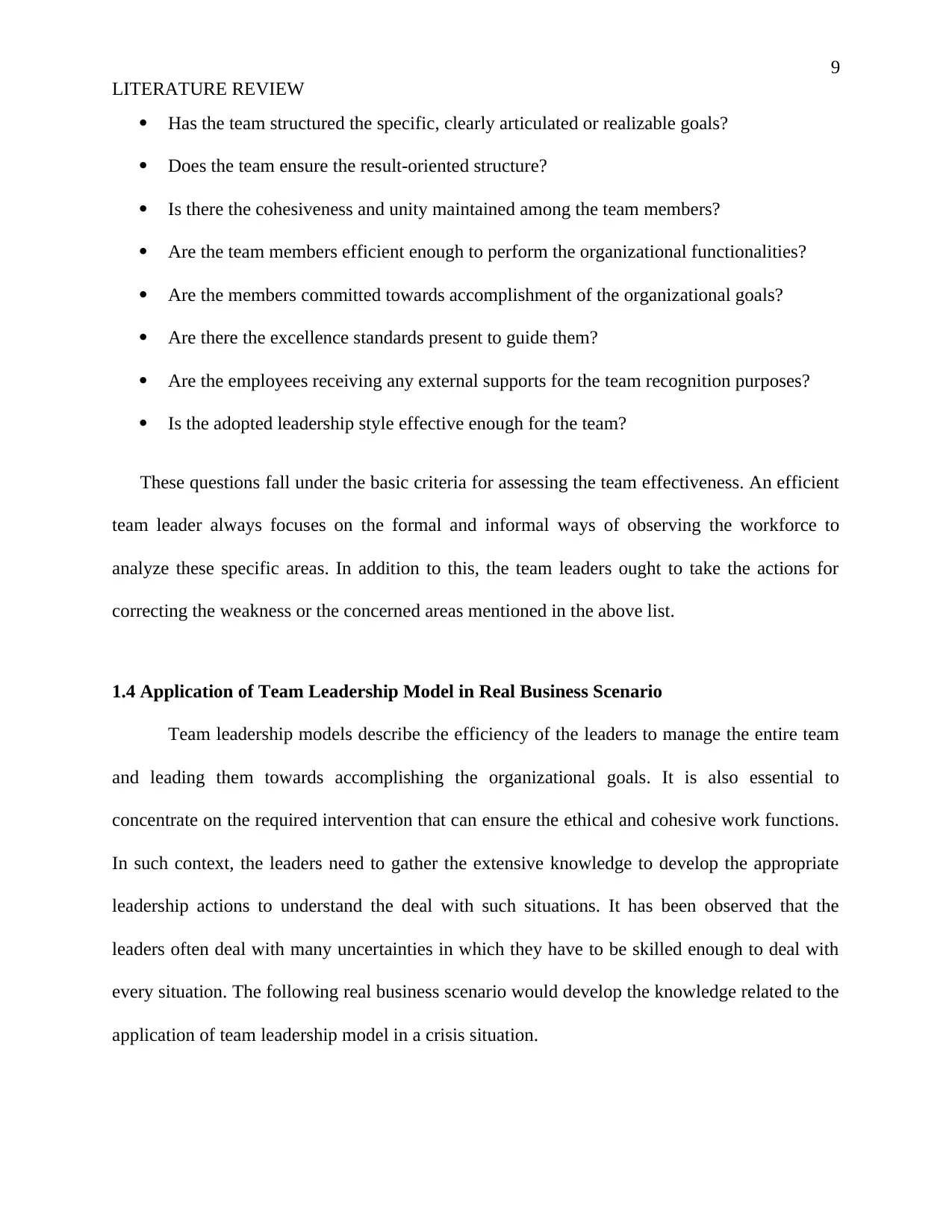
9
LITERATURE REVIEW
Has the team structured the specific, clearly articulated or realizable goals?
Does the team ensure the result-oriented structure?
Is there the cohesiveness and unity maintained among the team members?
Are the team members efficient enough to perform the organizational functionalities?
Are the members committed towards accomplishment of the organizational goals?
Are there the excellence standards present to guide them?
Are the employees receiving any external supports for the team recognition purposes?
Is the adopted leadership style effective enough for the team?
These questions fall under the basic criteria for assessing the team effectiveness. An efficient
team leader always focuses on the formal and informal ways of observing the workforce to
analyze these specific areas. In addition to this, the team leaders ought to take the actions for
correcting the weakness or the concerned areas mentioned in the above list.
1.4 Application of Team Leadership Model in Real Business Scenario
Team leadership models describe the efficiency of the leaders to manage the entire team
and leading them towards accomplishing the organizational goals. It is also essential to
concentrate on the required intervention that can ensure the ethical and cohesive work functions.
In such context, the leaders need to gather the extensive knowledge to develop the appropriate
leadership actions to understand the deal with such situations. It has been observed that the
leaders often deal with many uncertainties in which they have to be skilled enough to deal with
every situation. The following real business scenario would develop the knowledge related to the
application of team leadership model in a crisis situation.
LITERATURE REVIEW
Has the team structured the specific, clearly articulated or realizable goals?
Does the team ensure the result-oriented structure?
Is there the cohesiveness and unity maintained among the team members?
Are the team members efficient enough to perform the organizational functionalities?
Are the members committed towards accomplishment of the organizational goals?
Are there the excellence standards present to guide them?
Are the employees receiving any external supports for the team recognition purposes?
Is the adopted leadership style effective enough for the team?
These questions fall under the basic criteria for assessing the team effectiveness. An efficient
team leader always focuses on the formal and informal ways of observing the workforce to
analyze these specific areas. In addition to this, the team leaders ought to take the actions for
correcting the weakness or the concerned areas mentioned in the above list.
1.4 Application of Team Leadership Model in Real Business Scenario
Team leadership models describe the efficiency of the leaders to manage the entire team
and leading them towards accomplishing the organizational goals. It is also essential to
concentrate on the required intervention that can ensure the ethical and cohesive work functions.
In such context, the leaders need to gather the extensive knowledge to develop the appropriate
leadership actions to understand the deal with such situations. It has been observed that the
leaders often deal with many uncertainties in which they have to be skilled enough to deal with
every situation. The following real business scenario would develop the knowledge related to the
application of team leadership model in a crisis situation.
Paraphrase This Document
Need a fresh take? Get an instant paraphrase of this document with our AI Paraphraser
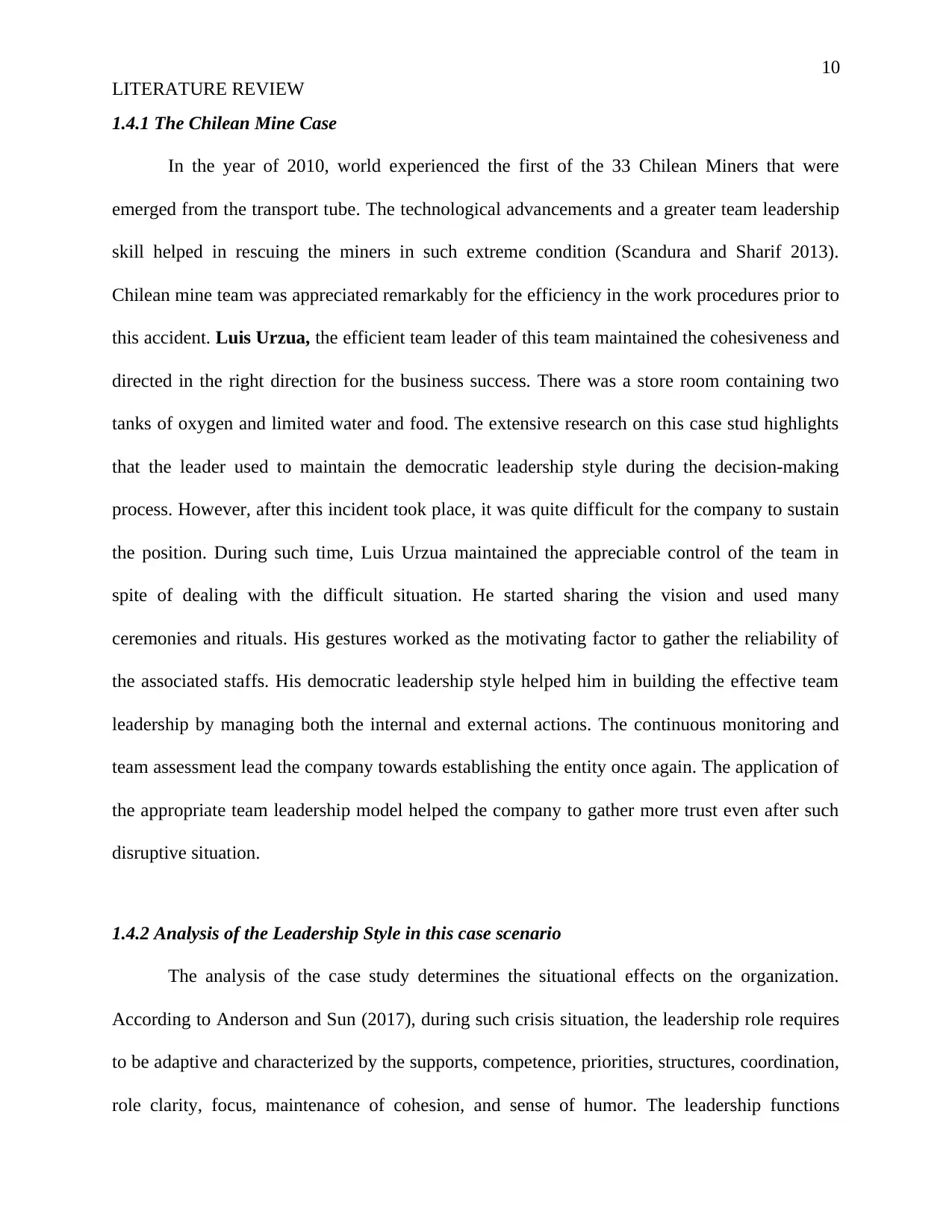
10
LITERATURE REVIEW
1.4.1 The Chilean Mine Case
In the year of 2010, world experienced the first of the 33 Chilean Miners that were
emerged from the transport tube. The technological advancements and a greater team leadership
skill helped in rescuing the miners in such extreme condition (Scandura and Sharif 2013).
Chilean mine team was appreciated remarkably for the efficiency in the work procedures prior to
this accident. Luis Urzua, the efficient team leader of this team maintained the cohesiveness and
directed in the right direction for the business success. There was a store room containing two
tanks of oxygen and limited water and food. The extensive research on this case stud highlights
that the leader used to maintain the democratic leadership style during the decision-making
process. However, after this incident took place, it was quite difficult for the company to sustain
the position. During such time, Luis Urzua maintained the appreciable control of the team in
spite of dealing with the difficult situation. He started sharing the vision and used many
ceremonies and rituals. His gestures worked as the motivating factor to gather the reliability of
the associated staffs. His democratic leadership style helped him in building the effective team
leadership by managing both the internal and external actions. The continuous monitoring and
team assessment lead the company towards establishing the entity once again. The application of
the appropriate team leadership model helped the company to gather more trust even after such
disruptive situation.
1.4.2 Analysis of the Leadership Style in this case scenario
The analysis of the case study determines the situational effects on the organization.
According to Anderson and Sun (2017), during such crisis situation, the leadership role requires
to be adaptive and characterized by the supports, competence, priorities, structures, coordination,
role clarity, focus, maintenance of cohesion, and sense of humor. The leadership functions
LITERATURE REVIEW
1.4.1 The Chilean Mine Case
In the year of 2010, world experienced the first of the 33 Chilean Miners that were
emerged from the transport tube. The technological advancements and a greater team leadership
skill helped in rescuing the miners in such extreme condition (Scandura and Sharif 2013).
Chilean mine team was appreciated remarkably for the efficiency in the work procedures prior to
this accident. Luis Urzua, the efficient team leader of this team maintained the cohesiveness and
directed in the right direction for the business success. There was a store room containing two
tanks of oxygen and limited water and food. The extensive research on this case stud highlights
that the leader used to maintain the democratic leadership style during the decision-making
process. However, after this incident took place, it was quite difficult for the company to sustain
the position. During such time, Luis Urzua maintained the appreciable control of the team in
spite of dealing with the difficult situation. He started sharing the vision and used many
ceremonies and rituals. His gestures worked as the motivating factor to gather the reliability of
the associated staffs. His democratic leadership style helped him in building the effective team
leadership by managing both the internal and external actions. The continuous monitoring and
team assessment lead the company towards establishing the entity once again. The application of
the appropriate team leadership model helped the company to gather more trust even after such
disruptive situation.
1.4.2 Analysis of the Leadership Style in this case scenario
The analysis of the case study determines the situational effects on the organization.
According to Anderson and Sun (2017), during such crisis situation, the leadership role requires
to be adaptive and characterized by the supports, competence, priorities, structures, coordination,
role clarity, focus, maintenance of cohesion, and sense of humor. The leadership functions
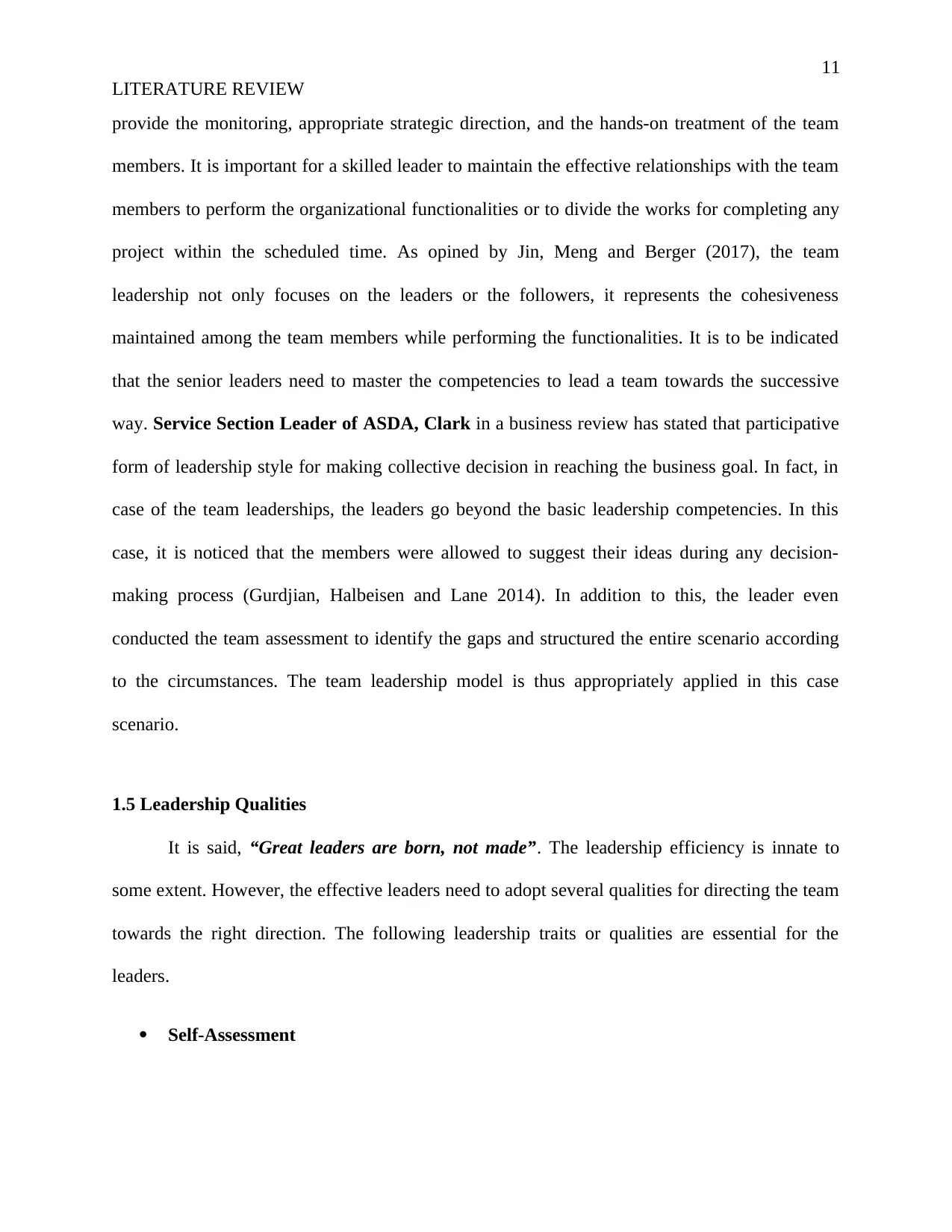
11
LITERATURE REVIEW
provide the monitoring, appropriate strategic direction, and the hands-on treatment of the team
members. It is important for a skilled leader to maintain the effective relationships with the team
members to perform the organizational functionalities or to divide the works for completing any
project within the scheduled time. As opined by Jin, Meng and Berger (2017), the team
leadership not only focuses on the leaders or the followers, it represents the cohesiveness
maintained among the team members while performing the functionalities. It is to be indicated
that the senior leaders need to master the competencies to lead a team towards the successive
way. Service Section Leader of ASDA, Clark in a business review has stated that participative
form of leadership style for making collective decision in reaching the business goal. In fact, in
case of the team leaderships, the leaders go beyond the basic leadership competencies. In this
case, it is noticed that the members were allowed to suggest their ideas during any decision-
making process (Gurdjian, Halbeisen and Lane 2014). In addition to this, the leader even
conducted the team assessment to identify the gaps and structured the entire scenario according
to the circumstances. The team leadership model is thus appropriately applied in this case
scenario.
1.5 Leadership Qualities
It is said, “Great leaders are born, not made”. The leadership efficiency is innate to
some extent. However, the effective leaders need to adopt several qualities for directing the team
towards the right direction. The following leadership traits or qualities are essential for the
leaders.
Self-Assessment
LITERATURE REVIEW
provide the monitoring, appropriate strategic direction, and the hands-on treatment of the team
members. It is important for a skilled leader to maintain the effective relationships with the team
members to perform the organizational functionalities or to divide the works for completing any
project within the scheduled time. As opined by Jin, Meng and Berger (2017), the team
leadership not only focuses on the leaders or the followers, it represents the cohesiveness
maintained among the team members while performing the functionalities. It is to be indicated
that the senior leaders need to master the competencies to lead a team towards the successive
way. Service Section Leader of ASDA, Clark in a business review has stated that participative
form of leadership style for making collective decision in reaching the business goal. In fact, in
case of the team leaderships, the leaders go beyond the basic leadership competencies. In this
case, it is noticed that the members were allowed to suggest their ideas during any decision-
making process (Gurdjian, Halbeisen and Lane 2014). In addition to this, the leader even
conducted the team assessment to identify the gaps and structured the entire scenario according
to the circumstances. The team leadership model is thus appropriately applied in this case
scenario.
1.5 Leadership Qualities
It is said, “Great leaders are born, not made”. The leadership efficiency is innate to
some extent. However, the effective leaders need to adopt several qualities for directing the team
towards the right direction. The following leadership traits or qualities are essential for the
leaders.
Self-Assessment
⊘ This is a preview!⊘
Do you want full access?
Subscribe today to unlock all pages.

Trusted by 1+ million students worldwide
1 out of 21
Related Documents
Your All-in-One AI-Powered Toolkit for Academic Success.
+13062052269
info@desklib.com
Available 24*7 on WhatsApp / Email
![[object Object]](/_next/static/media/star-bottom.7253800d.svg)
Unlock your academic potential
Copyright © 2020–2025 A2Z Services. All Rights Reserved. Developed and managed by ZUCOL.





